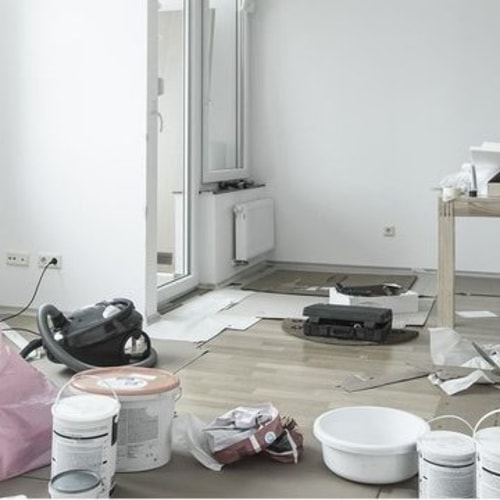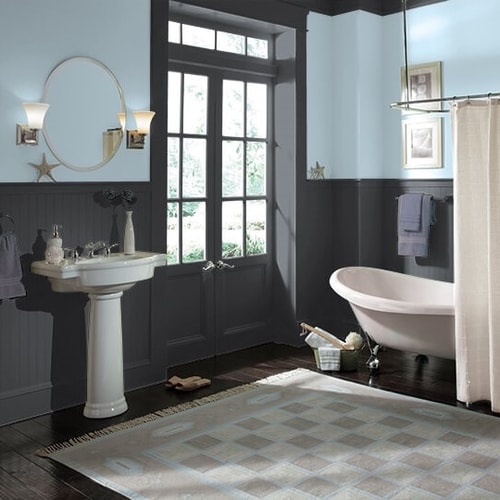Bathrooms are fun to paint because you can set any mood you want in a small space. The primary things to consider when planning how to paint your bathroom are preparation, paint choice and application.

Paint supplies in room
Preparation
Before you can paint your bathroom, you'll need to make sure you have a smooth surface. The simplest way to do this is to carefully wash the walls with a clean rag, warm water and a little dish soap. As you wash, check the condition of the walls for holes, rough spots or dings in the wallboard. Lightly mark any damage by circling it with pencil. Repair holes and cracks with a bit of joint compound or spackle. Apply it sparingly, smooth it out and let it dry completely. Sand* the patch smooth, and if there's still a dip or a depression, apply another coat of spackle. Always let patching compound dry completely before applying paint. Do a final sanding* and vacuum away any dust both at the patch site and down the wall. Wipe the walls one last time with a damp cloth and allow to dry completely. Carefully remove outlet covers. Put the cover screw back in the outlet and soak the outlet covers in warm water and dish soap so you can scrub them up and put them back on clean. If you soak the screws, they may rust. Once the walls are completely dry and dust* free, apply good quality painter's tape to the trim around doors, windows and along the baseboard.Find Paint Products For Your Job

Freshly painted bathroom
Choosing the Right Paint and Tools
Consider the environmental conditions when looking for the right product to paint your bathroom. Bathrooms are generally loaded with moisture, so you'll need a mold and mildew resistant paint. Additionally, one of the big questions that comes up when working out how to paint my bathroom is that of tools. It's a small space. Will you need to use a roller or can you just use a brush?If you're interested in a particular texture, brushing your walls is a great option in this small space. However, if you want a smooth finish, you're better off cutting in with a small brush against the painter's tape and rolling the paint on with a mini-roller.
When deciding how to paint your bathroom, it can be tempting to skip the painter's tape. However, even those with the steadiest hand can get tired as the day goes on, and you may not be able to cut in cleanly. Working with a short-handled paint brush can reduce this fatigue, but using painter's tape is the best way to confirm a clean finish.
Deciding how to paint your bathroom takes time, but there's no better feeling in any space than a fresh coat of paint. With proper preparation and the right paint, you can create a finished wall coat in your bathroom that will last.
Find The Perfect Bathroom Color
*WARNING! If you scrape, sand, or remove old paint, you may release lead dust. LEAD IS TOXIC. EXPOSURE TO LEAD DUST CAN CAUSE SERIOUS ILLNESS, SUCH AS BRAIN DAMAGE, ESPECIALLY IN CHILDREN. PREGNANT WOMEN SHOULD ALSO AVOID EXPOSURE. Wear a NIOSH-approved respirator to control lead exposure. Clean up carefully with a HEPA vacuum and a wet mop. Before you start, find out how to protect yourself and your family by contacting the National Lead Information Hotline at 1-800-424-LEAD or log on to www.epa.gov/lead.


